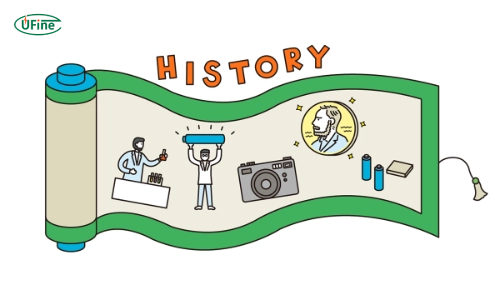
In today’s tech world, lithium-ion batteries are essential. They power gadgets, cars, and green energy solutions. But who invented the lithium-ion battery, and how did it change our world? Let’s explore the origins of this groundbreaking technology and how it has improved our lives.
Part 1. Lithium-ion battery history
Early Battery History
Before lithium-ion batteries, there were other kinds. Alessandro Volta made one called the Voltaic Pile a long time ago. That was just the beginning! More cool stuff happened in science in the 1800s and early 1900s, making batteries even better.
Emergence of Lithium-ion Technology
Lithium-ion batteries improved because of intelligent people like M. Stanley Whittingham, Rachid Yazami, and Akira Yoshino. In the 1970s, Whittingham looked at titanium stuff. Yazami used graphite in the 1980s, making batteries work much better. They made our gadgets awesome!
In the 1980s, Akira Yoshino made batteries much better. He used unique stuff like carbon for one part and lithium cobalt oxide for another, making the first good lithium-ion battery. Sony started selling these excellent batteries in 1991, making our gadgets much cooler.
Part 2. The contributions of John B. Goodenough
John B. Goodenough’s Background
John B. Goodenough, born in 1922, was an intelligent scientist in America. He’s good at studying materials and batteries. He went to a famous school, the University of Chicago, and got a degree in Math. After that, he studied Physics and earned a Ph.D. from the same school.
Goodenough is an intelligent person who did extraordinary things in school and research. He liked studying tiny things in materials. His interest in how things stick together helped him make excellent batteries.
John B. Goodenough’s Research
Goodenough did something super crucial for batteries. In the 1980s, while working at a school, he found a unique material called cobalt oxide. This made batteries much better and changed how we store energy.
Goodenough’s significant discovery made perfect batteries. These batteries are strong, work well, and stay safe. Because of him, we can have cool gadgets, electric cars, and green energy.
Part 3. The work of Stanley Whittingham
Lithium Cobalt Oxide Cathode
Whittingham did important work in the 1970s. He made the first lithium-ion battery by trying out lithium and titanium disulfide. Putting lithium ions into the titanium disulfide made the battery store energy. But it had a problem – it wasn’t very safe because of the lithium part.
Whittingham’s Contributions
Whittingham did something big by making a part called lithium cobalt oxide for the battery. This made the battery safer and stored more energy. When he used it with the lithium part, the battery became better and could be used many times. Because of him, we have better batteries for toys and gadgets.
Part 4. Akira Yoshino and commercialization
Akira Yoshino’s Innovations
Akira Yoshino, a Japanese chemist, engineer, and inventor, significantly contributed to the commercialization of the lithium-ion battery. His journey began with a degree in Petrochemicals from Kyoto University, where he delved into research in lithium-ion batteries.
Yoshino did something unique in 1985. He worked at Asahi Kasei Corporation and made the first good lithium-ion battery. Instead of using something unsafe called lithium metal, he used a safer thing called petroleum coke. This change made the battery better, safer, and suitable for everyone.
Nobel Prize in Chemistry
In 2019, three competent scientists, Akira Yoshino, John B. Goodenough, and Stanley Whittingham, got a big prize called the Nobel Prize in Chemistry. They got it because they made better batteries for our gadgets and cars. This made things like phones and electric cars work better, and we can use more clean energy.
Yoshino did something remarkable. He found a better way to make lots of batteries. This helped many industries, making batteries safer and better for the environment. Thanks to him, our future with technology will be safer and more sustainable.
Part 5. Battery research
Ongoing Research and Development
In the world of batteries, researchers are constantly working to make them better. Scientists and engineers do many things to improve how batteries work, making them safer and better for the environment.
Advancements in Anode and Cathode Materials
Scientists are trying to make batteries better by finding new stuff for them. They want batteries to store more energy, last longer, and work even better. They are looking at things like silicon for one part and unique materials for the other to make batteries do more cool things.
Solid-State Batteries
Scientists are trying something new with batteries called solid-state batteries. Regular batteries use liquid inside, but these new ones use solid stuff. This makes them safer and reduces the risk of getting too hot. They might also store more energy. Researchers are working hard to make and bring these special batteries to stores.
Advanced Battery Management Systems (BMS)
Scientists are trying to improve battery systems called Battery Management Systems (BMS). These are superheroes that watch over each battery to ensure they work well and stay safe. If we improve these BMS, batteries can last longer, charge faster, and perform better.
Future Prospects
The future of batteries holds promising prospects, with several areas showing potential for transformative breakthroughs:
Beyond Lithium-ion
Researchers are exploring post-lithium technologies, such as sodium-ion and potassium-ion batteries. These alternatives aim to address resource availability concerns associated with lithium while maintaining or improving energy storage capabilities.
Artificial Intelligence Integration
Scientists are using intelligent computer programs, called AI, to help batteries work even better. These programs can watch how we use batteries, predict how they will do, and decide the best way to charge and use them for the most efficiency.
Recycling and Sustainability
Scientists want to make batteries that are good for the Earth. They are finding ways to use materials that are easy to recycle. This helps reduce waste from our gadgets and is better for nature.
Part 6. FAQs
-
Who owns most of the world’s lithium?
Several countries, including Australia, Chile, China, and Argentina, hold significant lithium reserves. Companies like Albemarle, SQM, and Ganfeng Lithium are prominent in lithium mining and production. -
Who produces the most lithium batteries in the world?
Companies like CATL (Contemporary Amperex Technology Co. Ltd.), LG Energy Solution, and Panasonic are among the leading manufacturers of lithium batteries globally. -
Is it safe to store lithium batteries in the house?
It is generally safe to store lithium batteries in the house if proper precautions are taken, such as keeping them in a cool, dry place away from direct sunlight, heat sources, or flammable materials. A fireproof container or a LiPo safety bag is advisable for extra safety. -
How do you dispose of lithium batteries?
Proper disposal of lithium batteries involves recycling them through designated recycling centers or drop-off locations. Many electronics retailers and waste management facilities accept lithium batteries for recycling to prevent environmental contamination and recover valuable materials. Avoid disposing of them in regular household waste to prevent ecological harm.
Related Tags:
More Articles

Battery Load Test: A Comprehensive Guide
Step-by-step battery load test guide for car, solar & industrial use. Learn how to load test a battery, interpret voltage charts, and avoid common mistakes.
The Comprehensive Guide to Battery Balancing and Battery Balancer
Discover how battery balancers improve lithium battery performance, lifespan, and safety. Learn types, functions, and tips to choose the right balancer.
What Is the Best Voltage for a Chainsaw Battery?
Compare 12V-80V chainsaw batteries for light pruning, medium firewood, and professional cutting. See best battery chainsaw with runtime charts and safety tips.
Lithium VS. Alkaline Batteries: A Comprehensive Comparison
Lithium batteries last 3–7× longer than alkaline and perform better in cold weather. Compare lifespan, cost, safety, and best uses to choose the right battery.
Comparing Lithium-Sulfur and Lithium-Ion Batteries: Which is Right for You?
Compare lithium-sulfur (Li-S) and lithium-ion batteries on energy, lifespan, cost, safety, and applications. Best choice for drones, EVs, and electronics.






